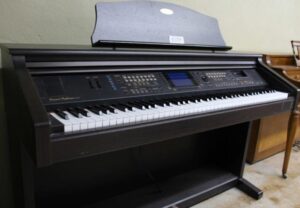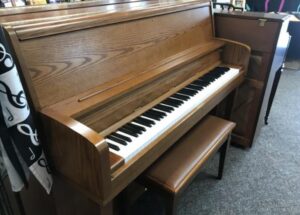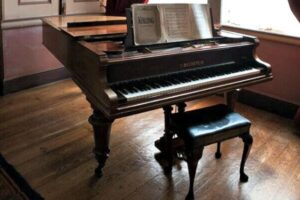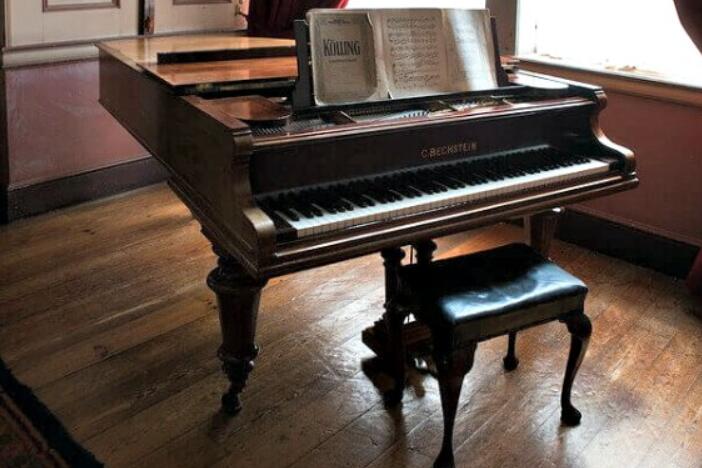Pianos are stringed musical instruments invented in Italy, whose strings are fixed by striking them with a wooden hammer and coated with a smoother material.
It has a keyboard with a row of keys in which a piano player presses with their fingers when playing the piano. Some of them are equipped with a wooden case that protects the metal strings and the soundboard.
Once one or many keys have been pressed, the hammer can be rigid or plastic strikes the strings. The hammer then rebounds off the strings, and they start vibrating as per the resonant frequency.
There are two significant categories of pianos: digital piano and acoustic piano. Below will introduce more information about digital piano vs acoustic piano.
What Is a Digital Piano?

A digital piano is an electronic keyboard instrument designed to be used in place of the traditional acoustic piano.
In both the sound it produces and the playing feeling, these pianos use either recorded samples or synthesized emulations from acoustic pianos that are amplified on an internal loudspeaker. They as well include weighted keys that give new life to the feeling of an acoustic piano.
Digital pianos are made in two designs, that is, upright piano and grand pianos. Like all the other musical instruments, digital pianos can get connected to PA systems or amplifiers to produce loud sounds in large venues.
Furthermore, tuning digital pianos is no need since their tuning can get modified to match another instrument’s tuning. They are mostly used in music studios and music schools to replace traditional musical instruments.
Benefits of Buying a Digital Piano
Every musical studio or school needs a piano as the first essential musical instrument to learn everything about music. Digital pianos have unique and more advanced features as compared to any other traditional piano.
Therefore, many benefits are attached to buying a digital piano for beginners or experts who love music and playing instruments. The following are the main benefits of owning a digital piano:
-
MIDI features
Digital pianos offer MIDI connections, enabling them to be controlled or control sequencers and other electronic musical instruments.
Some of them have an external storage slot that saves and loads MIDI data, which the piano will play automatically later as it has been set, thus functioning as a player piano.
Others are equipped with an in-built sequencer that helps in composition.
-
Piano emulation
Digital pianos produce sounds based on sampling. The sample sounds stored in these pianos are always created by professional microphones, high-quality preamps, and high-quality pianos in professional recording studios.
One keystroke is provided with multiple samples, trying to diversify sounds discovered in acoustic pianos.
They lack incidental noises like the acoustic ones associated with playing the piano, for instance, when pedals are depressed and concerned with machinery shifting within a piano.
-
Other instrument timbres
Most digital pianos have the ability to produce a variety of various piano timbres. For instance, digital pianos can have settings for concert upright piano, grand piano, a tack piano, and many different electric piano models and brands.
A digital piano can imitate other keyboard instruments such as organ, clavichord, and harpsichord; other digital pianos blend basic synthesizer sounds like the drum kits, string ensemble, and horns.
Several high-end digital pianos offer a wide range of instrumental sounds like electronic keyboards known to ensemble all pianos or specifically digital pianos.
-
Enables players to use headphones
The ability to play the piano while wearing headphones is so significant as it allows one to do their practice at any time of the day without distracting others. It maintains the privacy of the piano player as no one will notice when they make weird sounds.
Best Kit – Yamaha YDP 164 Digital Piano for Home
- Your purchase includes One Yamaha Arius Series, YDP164 model | Bench, 50 Classical Music Masterpieces Book, Owner’s manual & Quick Operation Guide
- Piano dimensions – 53-7/16” W x 33-27/64” H x 16-5/8” | Weight – 92 lbs. | Number of pedals – 3 | Max polyphony – 192 | Number of voices – 10 | Headphones – (2) Standard Stereo phone jack | With Recording and Playback capabilities
- GHS weighted action is heavier in the low keys and lighter in the high keys, just like an acoustic piano
- Half-damper pedal control allows for continuously increasing amounts of sustain as the pedal is depressed
- The CFX Premium Grand Piano Voice recreates the power and tone of the flagship CFX concert grand piano from Yamaha
- The special matte black key tops are designed to absorb moisture and remain tactile after extended use without becoming slippery
What Is an Acoustic Piano?

It is an old school piano that produces sound through the covered hammer, either wooden or plastic, hitting the steel-wire piano strings.
The keys of this piano are connected to the hammer. They are pressing one piano key causes the hammer to move and strike the string, causing some vibrations, thus producing sounds.
They are also available in two types, that is upright acoustic piano and the grand piano. Acoustic pianos as well are available in various brands such as Suzuki, Yamaha, Casio Privia, FLYCHORD DP 420K, among other brands.
Benefits of Buying an Acoustic Piano
Sometimes it is a bit challenging to determine the type of piano to use for your musical purposes. An acoustic piano can be suitable for beginners who are practicing how to handles and use a piano.
The following are benefits attached to buying an acoustic piano:
-
The sound or tone
Sound is an essential factor for everyone using a piano, be it an expert or a beginner. An acoustic piano has a rich and full sound; these sounds have a great inspiration, especially to beginners, because it makes them feel like they want more to become successful.
Experts get the urge to play more and bring out the best sounds and tones to their audience or background music.
-
They are compassionate to touch
The force at which a pianist presses the piano key is determining the intensity and loudness of how the pressed key responds.
Touch responses vary depending on the type of acoustic piano used, but in most cases, this feature is natural to all acoustic pianos. Therefore, it makes it easy to play and produce the desired sound as it is supposed to be.
-
Acoustic pianos great feel
Feel is a significant factor mostly in beginners; it can adversely affect their performance or positively inspire them to anticipate more.
An acoustic piano has textured keys that prevent fingers from slipping over them. The keys’ weight is not exaggerated or underrated, thus making it easy for users to adapt.
It gives a pianist the authentic piano experience, enabling them to freely explore, improvise, and learn about acoustic pianos.
Best of the Best – Suzuki CTP-88 Acoustic Piano
- With the Bluetooth compatibility wireless networking enables any wireless device to connect to your CTP-88 Digital piano for expanded and convenient operation
- Your iPad advantage - connect the CTP-88 to your iPad and convert it into a recording studio! Makes practice and playing time a lot more fun. If you have kids, it might make all the difference in encouraging them to practice!
- The CTP-88 has a USB port that opens a world of exciting Add-ons and extra functionality. Plug and play directly with your laptop or desktop computers. You can use the midi ports to transmit/receive data from other musical instruments or other accessories
- Play along songs & built-in music teacher-choose from 55 preset songs for instant playing with the included songbook. Simple to advanced songs allow for separate practice. Engage the vocal grading feature for a true to form "piano teacher" Response
- An amazing combination of 128 MIDI voices, 100 rhythm styles and recording feature. Create your own original compositions with the on-board 3 track music sequencer. Save/store to the secure digital(sd) memory card using the full color LCD control screen
Acoustic piano vs. Digital Piano

Now you all understand both the acoustic and the digital pianos, their functions, meanings, and mechanisms; let us now distinguish each one of them according to the following aspects:
– Sound
Sound is the first key thing that differentiates the two instruments. It has been found that the acoustic piano does produce a better sound as compared to the digital computer.
It makes its sound once the hammer strikes the string, bringing out an acoustic sound with a warm and more resonant tone. The player has better control over the expression and articulation of musical styles.
On the other hand, a digital piano only mimics acoustic piano’s sounds; its sound being from a digital doesn’t allow similar acoustic nuances.
Besides, a high-end digital piano tends to sound better as compared to a low-end acoustic piano.
– Maintenance
Acoustic pianos need more and frequent maintenance. The steel strings, the wooden exterior cover, and the hammers are more delicate; thus, they need proper care; one needs to be more careful on an acoustic piano in:
- Tuning: To ensure your piano is on tune, you have to ensure that it is tuned at least twice a year; in most cases, you will need a professional to do this, which might be quite expensive.
- Vulnerability to temperature and humidity fluctuations: Wood usually is susceptible to both temperature and humidity. Keeping in uncomfortable conditions can easily affect the components of the acoustic piano.
This is not the case for digital pianos since they do not contain any sensitive parts sensitive to environmental changes, thus requiring minimal maintenance.
– Touch sensitivity
There is a vast difference in the touch and feel of a digital piano and an acoustic piano.
- The key weights bring it about; more strength is needed when striking an acoustic piano’s keys.
- For the digital piano case, only a very gentle touch on the keys leads to sound production.
Several manufacturers have tried to make up for this feature in digital pianos by introducing weighted keys, which tend to mimic acoustic piano keys’ weight.
Some pianists more prefer acoustic pianos because they are more sensitive. The strength used and the finger movements are the main determinants of the tone.
Therefore, easy production of different sound shades on one key. On a digital piano, since it produces digital sounds, it has limited tones to be made by one key.
Conclusion
Pianos are essential musical instruments; therefore, everyone should be keen on which piano to buy depending on their experience and likes.
Both digital and acoustic pianos can be used for musical purposes to perform the same function, but space and other minor key things should always be considered.
It is essential to consult a professional pianist to guide you on which type of piano to go for if you a beginner willing to learn or an expert to shape their more. Price is another determinant; one should go where they get their value for money.



